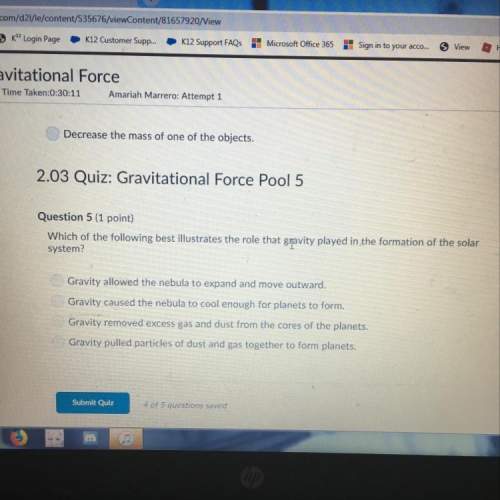
Chemistry, 10.11.2020 17:50, naomicervero
Directions Now that the lab is complete, it is time to write your lab report. The purpose of this guide is to help you write a clear and concise report that summarizes the lab you have just completed. The lab report is composed of two sections: Section I: Overview of Investigation o Provide background information. o Summarize the procedure. Section II: Observations and Conclusions o Include any charts, tables, or drawings required by your teacher. o Include answers to follow-up questions. o Explain how the investigation could be improved. To help you write your lab report, you will first answer the four questions listed below based on the lab that you have just completed. Then you will use the answers to these questions to write the lab report that you will turn in to your teacher. You can upload your completed report with the upload tool in formats such as OpenOffice. org, Microsoft Word, or PDF. Alternatively, your teacher may ask you to turn in a paper copy of your report or use a web-based writing tool. Questions Section I: Overview of Lab 1. What is the purpose of the lab? Lab Report Guide 2;What procedure did you use to complete the lab? Outline the steps of the procedure in full sentences. Section II: Observations and Conclusions 3. What charts, tables, or drawings would clearly show what you have learned in this lab? Each chart, table, or drawing should have the following items: a. An appropriate title b. Appropriate labels Lab Report Guide 4. If you could repeat the lab and make it better, what would you do differently and why? There are always ways that labs can be improved. Now that you are a veteran of this lab and have experience with the procedure, offer some advice to the next scientist about what you suggest and why. Your answer should be at least two to three sentences in length. Writing the Lab Report Now you will use your answers from the four questions above to write your lab report. Follow the directions below. Section I: Overview of Lab Use your answers from questions 1 and 2 (above) as the basis for the first section of your lab report. This section provides your reader with background information about why you conducted this lab and how it was completed. It should be one to two paragraphs in length. Section II: Observations and Conclusions Use your answers from questions 3 and 4 (above) as the basis for the second section of your lab report. This section provides your reader with charts, tables, or drawings from the lab. You also need to incorporate your answers to the follow-up questions (from the Student Guide) in your conclusions. Overall When complete, the lab report should be read as a coherent whole. Make sure you connect different pieces with relevant transitions. Review for proper grammar, spelling, punctuation, formatting, and other conventions of organization and good writing

Answers: 1
Other questions on the subject: Chemistry

Chemistry, 22.06.2019 02:50, Jerrikasmith28
The conventional equilibrium constant expression (kc) for the system below is: 2icl(s) ⇄ i2(s) + cl2(g) [cl2] ([i2] + [cl2])/2[icl] [i2][cl2]/[icl]2 none of the listed answers are correct [i2][cl2]/2[icl]
Answers: 2

Chemistry, 22.06.2019 06:30, khalaflaf2684
If 1.8 l of water is added to 2.5l of a 7.0 m koh solution, what is the molarity of the new solution
Answers: 1

Chemistry, 22.06.2019 09:40, gonzaleze18
In the lab, ammonia was mixed with water to form ammonium hydroxide. what is/are the reactant(s)? o water and ammonia o ammonia o ammonium hydroxide need
Answers: 2

Chemistry, 22.06.2019 14:30, jessiereyes2924
What is the relationship between wind and ocean waves? question 17 options: wind moving at higher speeds will transfer more energy to the water, resulting in stronger waves. wind moving at higher speeds will transfer energy over a larger part of the ocean water, resulting in waves with a shorter wavelength. winds moving at higher speeds with cause water to move forward at faster rates, causing larger ocean waves. winds moving at higher speeds will affect deeper water, resulting in waves that move at a faster rate. how do temperature and salinity affect deepwater currents? question 15 options: as temperatures and salinity levels of water increase, the water rises to the surface where it creates currents as it moves to colder regions. they create changes in wind direction, moving denser water in the same direction as the wind and causing the deepwater circulation patterns found in the ocean. they equalize the forces on undersea currents caused by the coriolis effect as they replace more dense water with less dense water. they create density differences that cause dense deepwater currents to flow toward the equator where they displace less dense, warmer water above them.
Answers: 2
Do you know the correct answer?
Directions Now that the lab is complete, it is time to write your lab report. The purpose of this gu...
Questions in other subjects:




English, 13.09.2021 19:20



Biology, 13.09.2021 19:20

Advanced Placement (AP), 13.09.2021 19:20


English, 13.09.2021 19:20







